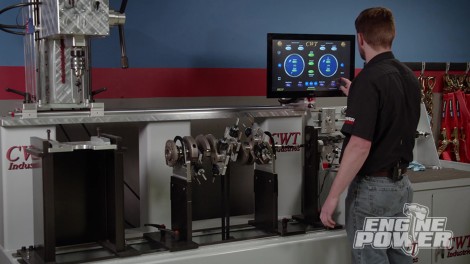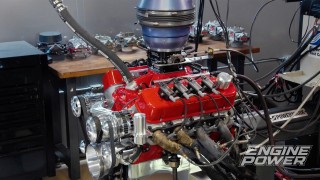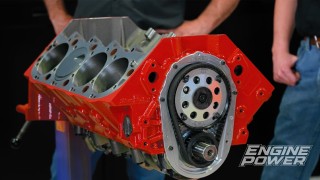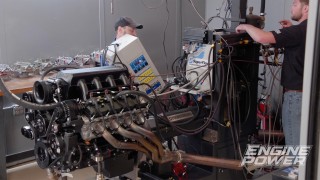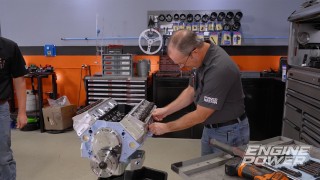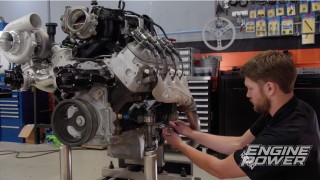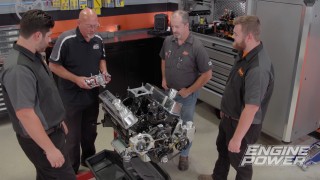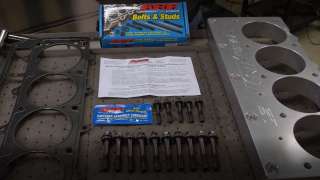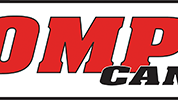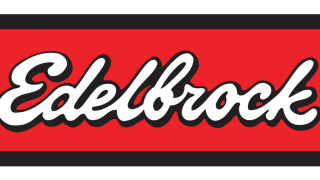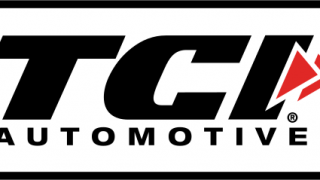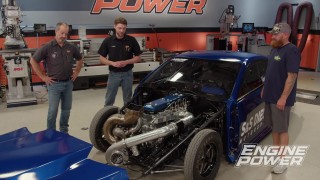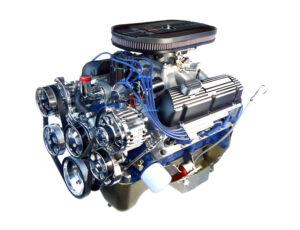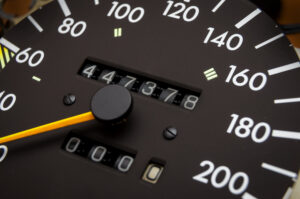Engine Power Featured Projects
Engine Power Builds
Want more content like this?
Join the PowerNation Email NewsletterParts Used In This Episode
Edelbrock
COMP Cams: World's top manufacturer of high-quality performance-based internal engine components.
Edelbrock
TCI Automotive: Leading provider of high performance automatic transmissions, torque converters, and drivetrain components.
CWT Industries
Multi-Bal 5500
Jesel Inc.
Jesel Belt Drive Kit
K1 Technologies
K1 Technologies Chevrolet 350 Crankshaft
Late Model Engines
Crower Rocker Arms
Late Model Engines
LME Billet Intake LS7 Manifold
Late Model Engines
LME CID LS7 Cylinder Heads
Late Model Engines
LME LS Tall Billet Valve Covers
Manley Performance
Manley Pro-Series I-Beam Connecting Rods
Sunnen Products Company
Sunnen SV-15 Honing Machine
Wiseco Performance Products
Wiseco Flat Top Pistons
World Products
Motown LS Iron Block
Video Transcript
(Pat)>> You're watching Powernation!
(Pat)>> Today on Engine Power we build a high compression race engine that's one-part small block Chevy and one part LS.
(Frankie)>> Plus, after years of ordering custom cam shafts we finally get to see how they're made. [ Music ]
(Pat)>> Hey everyone, welcome to Engine Power. Today we are extremely excited to start our new project. We are building a high compression race engine. We don't get to do them that often, but when we do we have a great time with it. This one is application specific, like all of our other builds, but this one is going down to our buddies in Carcass. They are building a 1972 split bumper Camaro race car and they needed some motivation for it. So we are putting some parts together and we are gonna make them some power, but before we got any of these parts we wanted to make sure we did the right thing for them. So we talked to Jeremy and Jimmy to see what kind of power they need.
(Jeremy)>> The reality behind this car is it's gonna be a real race car. It's not gonna see any time on the road. So as far as us really kinda beating on this thing it's gonna take a beating. So we need something that's gonna withstand how we drive.
(Jimmy)>> And we'll have you guys out at the track to maintain this for us because we don't want to be responsible for such a cool and expensive engine.
(Pat)>> We wouldn't have it any other way. Part of doing the engine in a real race operation is the engine builders go with the car, and they're the ones responsible for how well it runs. The adage is the chassis builder gets you to the finish line. The engine builder determines when.
(Frankie)>> After talking with the guys down in Carcass a bit more we determined that they need at least 700 horsepower and they need it in a small block naturally aspirated package. They also wanted something a bit unique. So the base of our build is going to be a World Products Motown LS block, and this is a little bit different. If you're not familiar it uses a small block Chevy bottom end but allows LS induction to be bolted to the top. This gives us the small block Chevy benefits of great windage control and a solid foundation but the high flow ability of LS heads. We're going to be filling it with K-1 Technologies four inch stroke forged crank shaft, a set of Manley I-beam connecting rods, and a forged 26-18 Wiseco set of pistons at 4.185 bore. If you're doing some quick math that means this engine is going to be 440 cubic inches. Those pistons are gonna be filled with Summit Racing's gas ported piston rings. For the heads we needed something that was gonna flow a ton of air. So we reached out to the guys at Late Model Engines, better known as LME, and they set us up with a set of their CID LS-7 castings, and they fit the bill perfectly. They flow over 400 c-f-m. They also gave us the set of Crower rockers that match them, the matching billet LS-7 intake, and as a special treat a set of their valve covers with our logo engraved in them. Jesel provided one of their belt drives that is specific to this engine. You don't see a cam shaft but we're gonna be getting that later. This engine is going to be fuel injected, and it's all gonna be controlled with a Holley HP e-c-u, and that will be a huge benefit in a road race car cause we won't have to deal with fuel sloshing or fuel evaporation like you would have with a carburetor. Now this is a ton of parts, and this is going to be a very extreme build. We're super excited. We can't wait to get it on the dyno and start thrashing on it, but there is a ton of work that needs to happen first, especially a ton of block machining and block prep that needs to happen before we can start assembly. So our first step is to get it in the Sunnen SV-15 cylinder hone and set our bore size and surface finish. [ Music ]
(Pat)>> With our block fastened down and the stones changed in our Sunnen SV-15 it is time to bolt our ICT billet torque plate to our block, and to do that we're gonna be using our favorite fasteners, ARP. They built a specific kit for this combination with an LS head on this particular block. These bolts are seven-sixteenths in diameter, not a stock 11 millimeter like an LS, and they also protrude out of the back of the torque plate the same amount as they do the cylinder head. So the distortion is the same for assembly. So we are good to go. These bolts are made out of 87-40 chromoly and have 180,000 p-s-i of tensile strength. Way higher than the o-e-m fastener. With all of their kits ARP includes their Ultra Torque lube and a very detailed set of instructions. Because these are not o-e-m fasteners they do not take o-e-m torque values. The instructions are there to make sure that you utilize these fasteners to their greatest potential. Virtually any fastener can be improved on an engine, and that's why we love ARP. If they don't have it they will make it for you. So we're gonna get all our stuff bolted up and get honing. We'll use a spare Cometic m-l-s head gasket that's just like the one we're using during engine assembly. The torque plate is torqued down in sequence to a final value of 70-pound feet. Just like the cylinder head will be later. Using a 220-grit diamond abrasive, we will get within two ten-thousandths of final size. This creates correct bore geometry and the base for our final finish. Our block was precision bored to 10-thousandths undersize by our favorite machine shop, Shacklett Automotive. We'll switch to a 600-grit diamond to set both final size and proper plateau finish for our application. [ Music ] As always, we checked every cylinder with a profilometer. [ Music ]
(Frankie)>> It's like we're in heaven. Just engine parts everywhere!
(Pat)>> Up next, two kids in a candy store.
(Frankie)>> Whether it's an off the shelf design or a custom grind, for years we have depended on Comp Cams to provide precisely the cam shaft we need. So of course we reached out to them for help on the Carcass road course Camaro project.
(Pat)>> The cam shaft for our engine is custom in a couple of different ways. One, it is unique to our particular application and two, it is unique to the platform. So we came here to Memphis, Tennessee, right straight to the experts, Comp Cams. The leader in valvetrain technology, and low and behold our cam shaft is right here.
(Frankie)>> Kinda, this is what our cam shaft is gonna start out as, a solid chunk of 86-20 steel, but there's a ton of processes it needs to go through before we can actually put it in the engine. All that happens here at Comp Cams is in this facility. Everything from design, to packaging and shipping, and we have a really cool opportunity to watch as a custom cam gets built.
(Pat)>> Even though our Motown engine combines a small block Chevy bottom end with LS induction Comp Cams has got us covered.
(Chris)>> I think we've got a good series for you. We've got our RC Series of lobes. Really race oriented designs, but with your package they'll also provide the longevity and easy maintenance that you need. Good spring life out of it. 800 horsepower out of this thing should be no problem with this choice.
(Frankie)>> Using Comp's dedicated software, Chris showed us how our cam shaft would perform compared to other options. Once we got the cam all spec'ed out we wanted to see how Comp Cam shafts are actually made.
(Mark)>> Once we finish the engineering on the cam shaft and know exactly what we're gonna build we take it to a mill and it gets turned into what we call a "spool". So a round lobe spool. So basically all the spacing on the lobes is done, the journals are semi-finished, and it just looks like a round piece of bar stock except it's started to have some separations in it. As we take that spool we put it into our eco-mill, and it starts to shape the lobe so that it starts to look like a cam shaft, the oblong shape. What we'll do at that point is depending on the type of material the cam shaft is made of we'll get it close to the size, and then we'll take it and heat treat it at that point. Once it's heat treated then we can start getting to the next steps of actually finishing the cam shaft. We take it to one of our cam grinders or finishing machines. There's two steps. We do a rough grind on it, and then we do a finish grind on it. Obviously there are two different speeds. We just kinda get it close with the rough grind, and then we slow the machine down so that it puts a really nice finish. All the right concave, convex tapers. Whatever we're doing on that particular lobe is all done at that point, and then the cam shaft is near completion at that point. After that the cam shaft goes to our q-c lab. Everything on the cam shaft is checked. We check journal size, the lobes themselves to make sure that they match the profile or the design that we've picked for the cam shaft. Make sure the lobe separation is correct, the intake center line is correct, and all the cam shafts have a serial number on them. So that's how everything is traced back is based on that serial number. So this is where the cam shafts get their final checks. So we do some visual inspections on the cam shafts here as well as a digital inspection as well with our Adcole machine. You can see, what it's doing right is going through the process of checking three different spots on the lobe itself. So on both sides and in the middle. Check the journals as far as the size goes, and if it's good it goes in the box.
(Frankie)>> And that's every cam?
(Mark)>> Once it's gone through q-c and we know the cam shaft is exactly what we're supposed to have then if we do the MSE polishing, or the Mirco Surface Enhancement, it will go through that final process, get polished, and then it goes into the box.
(Frankie)>> Here tucked away in the back of the building we found the research and development center. They have a ton of cool toys, and this is where a lot of the development happens for new products.
(Pat)>> I cannot tell you how excited we are to be here. So let's get on in there and see what's going on. All of the Edelbrock group test their products here, including Edelbrock, TCI, and Comp Cams.
(Hunter)>> We perform performance testing, durability testing, and fully evaluate the products before they go to market. Often times start on the Spintrons where we'll track the valve motion, determine any performance benefits, and then go through a full durability there. Once it passes that test it'll move on to the engine dynos. On the engine dynos we'll check the horsepower performance and figure out what the power benefit of the product is. When that's completed often times it goes to a vehicle for further testing to make sure that there's no durability concerns in a running engine.
(Frankie)>> Now that we've seen firsthand what goes into the design, manufacturing, and testing of Comp Cams we've got an even deeper appreciation of their products. Coming up, from induction packages to TCI transmissions, we check out everything the Edelbrock group has to offer.
(Pat)>> Plus, the Motown LS gets the precision balance it needs for high r-p-m stability.
(Frankie)>> The Comp Cams facility was amazing. So we had to come just down the road to the Edelbrock Group headquarters here in Olive Branch. This isn't only their headquarters. It's also a warehouse and has manufacturing capability. It's a massive building and it has a ton of cool stuff inside. So I'm pretty excited to go in.
(Pat)>> Hopefully they'll let us take some stuff with us.
(Pat)>> Stop running, no running! This 300,000 square foot building became Edelbrock's home after the move from California to Mississippi.
(Trent)>> In the process of the move what we did is brought our intake manufacturing in house here in this facility. So what we do is we have our foundry based out of California. They cast all of our manifolds, superchargers, intakes, cylinder heads, anything you can imagine. What we do is get the raw castings in house here, and in turn we have our c-n-c machine operators turn them into a finished product to put on the shelf. It goes from step by step, q-c process of the castings to the finish machining goods. Every part of it is touched, as you'll see, and turns out to a great American made product.
(Frankie)>> The Edelbrock Group also includes Comp Cams, FAST, Russell Performance, and TCI Automotive. The spacious warehouse provides ample room for inventory. So chances are when you order anything it's in stock. That's something you simply cannot take for granted these days.
(Trent)>> One of the crucial parts of being a part of the Edelbrock Group is all the brands and all the products. What that means is a lot of things need to be on the shelf and readily available to ship out the door. We've got raw goods that have to be machined and assembled. We've got finished goods that are on the shelf and ready to ship. It's a constant flow that you have to maintain on a daily basis to make sure we supply our customers' needs.
(Pat)>> The technical support department fields about 1,000 calls a day, and their staff is ready to answer questions about a wide range of applications.
(Trent)>> The first customer could be a guy restoring a motorhome. Next guys could be racing tugboats. Valid statement, we make cam shafts for racing tugboats.
(Pat)>> That's hilarious!
(Frankie)>> For almost anything you're working on if it's got an engine Edelbrock's got the parts and knowledge to make it perform better. [ Music ]
(Pat)>> Just down the road in Ashland, Mississippi, we arrived at TCI. TCI was founded in 1968 as Torque Converters Incorporated. Today they sell complete high performance transmissions as well as drivetrain and transmission components. About 80 percent of their products go to street enthusiasts, with 20 percent headed to hardcore drag and circle track racers.
(Mark)>> TCI's been around for a long time, over 40 years. For the last 20 years it's been a part of the Comp Cams team. And now of course with the merger with Edelbrock now it's all one big happy family. Pretty much everything to do with transmissions, torque converters, and all the components that go around it. So it's definitely a complex line, especially when it comes to manufacturing all the transmissions, and building everything, all the torque converters, shifters, and everything that goes with it. So it's definitely a pretty full line.
(Frankie)>> It all starts with the core transmissions and torque converters that come in from all across the country. After thorough inspection and measurement only those units that are up to TCI's specifications will be rebuilt. The other 30 percent are rejected outright.
(Pat)>> The classic transmissions everyone remembers are still in high demand, but TCI is building those future classics as well.
(Mark)>> We do a lot of turbo-350s, 400s, some of the older school stuff, but as we progress absolutely we're doing a lot more of the modern electronic overdrive transmissions. We've got a new dyno that we can test these things with. Absolutely looking forward to the future of growing the business into new and more modern transmissions all the time.
(Frankie)>> If you need something built to order TCI is ready.
(Mark)>> We have a complete lineup of custom type stuff. Our Pro-X transmissions for the racing applications where they're a lot more specific to a type of racing or a type of vehicle. We can pretty much do just about anything you want when it comes to transmissions.
(Frankie)>> Quality assurance is critical. Every transmission is dyno tested before it ships.
(Mark)>> One of the big steps is dynoing the transmission. So that allows us to check all the pressures to make sure the transmission is shifting, make sure there's no leaks. All those types of things before the transmission goes out the door.
(Brian)>> Every part number we produce somebody cared about that as they were producing it because that is their life's work in that box.
(Pat)>> What's your favorite part of all this? You've been here 39 years. What gets you going to work in the morning?
(Jeff)>> I enjoy what I do. I'm a racer at heart. This is Jeff Reed, this is what I do. I get up at five o'clock every morning. I'm at work at five-thirty, and I leave between three-thirty and four every day. I live five minutes from here. I go to the local racetrack 30 minutes away. I go to Jackson, Tennessee. People go to the movies on weekends, more likely I'm at the track.
(Pat)>> With such a dedicated and experienced crew the Edelbrock Group continues to make the parts that gearheads want.
(Trent)>> So everything we done and what we've done is very purposeful, and we're gonna continue that going forward into the next upcoming years.
(Frankie)>> Up next, the Motown LS build continues with race ready piston rings and a balanced rotating assembly.
(Frankie)>> Welcome back to the shop where we are continuing on the build of our 440 cubic inch Motown LS now that we have our custom cam shaft. The next thing we're gonna be doing is balancing the rotating the assembly. This is something we do for every engine, but is extremely important on this one since as a road race engine it's gonna see extended time at high r-p-m. We're gonna be using our CWT Industries Multi-Bal 5500 to get our crankshaft exactly where we want it. We have all of our parts laid out. So we can start grabbing weights, building bob weights, and spin our crank. Every component is weighed individually and entered into CWT's software to automatically generate our bob weight. [ Music ] With each of the bob weights installed, we'll do our first spin to check the amount of imbalance in the crank. So we've gone ahead and got our first spin, and looking at the numbers this crank is very much out of balance but we knew we were gonna have that because we're using a heavy duty wrist pin for our power level. So it has a little bit more weight than a standard one. We're at 3.325-ounce inches on the rear and 2.49-ounce inches on the front, and that is actually a lot of imbalance. At 8,000 r-p-m, where this crank's gonna be turning, that's gonna put 377 pounds of force on the crank. So we're gonna get it tuned in and get it down to our tolerance of eighth ounce inch. So we don't have to add any new holes to our crankshaft we used the drill mounted on the machine to drill existing holes and a grinding wheel to remove material in order to get our crank to our balance tolerance. [ Music ] So we've got our crank balanced to our tolerance of eighth ounce inch, and we are well under that on the front and rear, and we have the forces on the opposite side of the crank. So we can see under this tab that on the center of the crank it minimized the force down to .042-ounce inch. So we're gonna save that as our last spin cause that looks good, and we can see on our print screen how much we've minimized the force on the crank down to just 12 pounds at 8,000 from 377, what it was before. So that looks good. We'll get it off and get it cleaned! We still have our Motown LS block in our Sunnen SV-15 cylinder hone cause we were letting some of that hone oil drain out of it, but with the torque plate still installed we're gonna take this opportunity to set our piston ring end gaps. When we started gathering parts for this build one of our first calls was to Total Seal Piston Rings because they have been a leader in piston ring and cylinder hone technology for racing. Everything from F-1 to circle track, and a lot of that technology has trickled down to benefit the hot rodder. We told them our parts combination and our application, and they immediately spec'ed out a piston ring set to match our pistons. They also recommended that we run a gas ported top ring. What that is is a recent innovation that they've come out with. They take the top piston ring and machine horizontal ports in the top of it to allow combustion gases to get behind the ring, force it out against the cylinder wall, and more effectively seal combustion, and that is a huge benefit because if we can't seal combustion we can't make horsepower. The ring set they spec'ed out is a 1.2-millimeter, 1.2-millimeter, 3-millimeter set with a steel top ring, a ductile iron second ring, and a steel oil control ring pack that is rated at 11 pounds. Cool innovation and technology like this is why we love working with Total Seal, and they've partnered with Summit Racing Equipment to offer that at an affordable price in Summit Racing's gas ported piston ring sets. We're gonna go ahead and get some of our rings in our cylinder bores, start checking them, and setting our piston ring end gaps. After installing the ring we'll use a modified piston ring compressor to square the ring in the bore. [ Music ] This is a file to fit ring set. So we can use the Summit Racing ring filer to set our top ring gap at 26 thousandths, and our second ring gap at 28 thousandths. [ Music ] Each ring is carefully deburred and checked in its cylinder. [ Music ]
(Pat)>> How'd you make out?
(Frankie)>> Pretty good! This is the last ring. So all the rings are gapped, the crank is balanced. We are moving along here.
(Pat)>> But we still have plenty to do. We have to get this block out, get it deburred, and get it cleaned so we can start putting parts in it. Then we are gonna assemble the bottom end, top end, and thrash this thing on the dyno so the guys down in Carcass have a great race bullet.
(Frankie)>> If you want to see more builds from us, everything from mild to racy like this one, you can go find Engine Power at Powernation.
Show Full Transcript
(Pat)>> Today on Engine Power we build a high compression race engine that's one-part small block Chevy and one part LS.
(Frankie)>> Plus, after years of ordering custom cam shafts we finally get to see how they're made. [ Music ]
(Pat)>> Hey everyone, welcome to Engine Power. Today we are extremely excited to start our new project. We are building a high compression race engine. We don't get to do them that often, but when we do we have a great time with it. This one is application specific, like all of our other builds, but this one is going down to our buddies in Carcass. They are building a 1972 split bumper Camaro race car and they needed some motivation for it. So we are putting some parts together and we are gonna make them some power, but before we got any of these parts we wanted to make sure we did the right thing for them. So we talked to Jeremy and Jimmy to see what kind of power they need.
(Jeremy)>> The reality behind this car is it's gonna be a real race car. It's not gonna see any time on the road. So as far as us really kinda beating on this thing it's gonna take a beating. So we need something that's gonna withstand how we drive.
(Jimmy)>> And we'll have you guys out at the track to maintain this for us because we don't want to be responsible for such a cool and expensive engine.
(Pat)>> We wouldn't have it any other way. Part of doing the engine in a real race operation is the engine builders go with the car, and they're the ones responsible for how well it runs. The adage is the chassis builder gets you to the finish line. The engine builder determines when.
(Frankie)>> After talking with the guys down in Carcass a bit more we determined that they need at least 700 horsepower and they need it in a small block naturally aspirated package. They also wanted something a bit unique. So the base of our build is going to be a World Products Motown LS block, and this is a little bit different. If you're not familiar it uses a small block Chevy bottom end but allows LS induction to be bolted to the top. This gives us the small block Chevy benefits of great windage control and a solid foundation but the high flow ability of LS heads. We're going to be filling it with K-1 Technologies four inch stroke forged crank shaft, a set of Manley I-beam connecting rods, and a forged 26-18 Wiseco set of pistons at 4.185 bore. If you're doing some quick math that means this engine is going to be 440 cubic inches. Those pistons are gonna be filled with Summit Racing's gas ported piston rings. For the heads we needed something that was gonna flow a ton of air. So we reached out to the guys at Late Model Engines, better known as LME, and they set us up with a set of their CID LS-7 castings, and they fit the bill perfectly. They flow over 400 c-f-m. They also gave us the set of Crower rockers that match them, the matching billet LS-7 intake, and as a special treat a set of their valve covers with our logo engraved in them. Jesel provided one of their belt drives that is specific to this engine. You don't see a cam shaft but we're gonna be getting that later. This engine is going to be fuel injected, and it's all gonna be controlled with a Holley HP e-c-u, and that will be a huge benefit in a road race car cause we won't have to deal with fuel sloshing or fuel evaporation like you would have with a carburetor. Now this is a ton of parts, and this is going to be a very extreme build. We're super excited. We can't wait to get it on the dyno and start thrashing on it, but there is a ton of work that needs to happen first, especially a ton of block machining and block prep that needs to happen before we can start assembly. So our first step is to get it in the Sunnen SV-15 cylinder hone and set our bore size and surface finish. [ Music ]
(Pat)>> With our block fastened down and the stones changed in our Sunnen SV-15 it is time to bolt our ICT billet torque plate to our block, and to do that we're gonna be using our favorite fasteners, ARP. They built a specific kit for this combination with an LS head on this particular block. These bolts are seven-sixteenths in diameter, not a stock 11 millimeter like an LS, and they also protrude out of the back of the torque plate the same amount as they do the cylinder head. So the distortion is the same for assembly. So we are good to go. These bolts are made out of 87-40 chromoly and have 180,000 p-s-i of tensile strength. Way higher than the o-e-m fastener. With all of their kits ARP includes their Ultra Torque lube and a very detailed set of instructions. Because these are not o-e-m fasteners they do not take o-e-m torque values. The instructions are there to make sure that you utilize these fasteners to their greatest potential. Virtually any fastener can be improved on an engine, and that's why we love ARP. If they don't have it they will make it for you. So we're gonna get all our stuff bolted up and get honing. We'll use a spare Cometic m-l-s head gasket that's just like the one we're using during engine assembly. The torque plate is torqued down in sequence to a final value of 70-pound feet. Just like the cylinder head will be later. Using a 220-grit diamond abrasive, we will get within two ten-thousandths of final size. This creates correct bore geometry and the base for our final finish. Our block was precision bored to 10-thousandths undersize by our favorite machine shop, Shacklett Automotive. We'll switch to a 600-grit diamond to set both final size and proper plateau finish for our application. [ Music ] As always, we checked every cylinder with a profilometer. [ Music ]
(Frankie)>> It's like we're in heaven. Just engine parts everywhere!
(Pat)>> Up next, two kids in a candy store.
(Frankie)>> Whether it's an off the shelf design or a custom grind, for years we have depended on Comp Cams to provide precisely the cam shaft we need. So of course we reached out to them for help on the Carcass road course Camaro project.
(Pat)>> The cam shaft for our engine is custom in a couple of different ways. One, it is unique to our particular application and two, it is unique to the platform. So we came here to Memphis, Tennessee, right straight to the experts, Comp Cams. The leader in valvetrain technology, and low and behold our cam shaft is right here.
(Frankie)>> Kinda, this is what our cam shaft is gonna start out as, a solid chunk of 86-20 steel, but there's a ton of processes it needs to go through before we can actually put it in the engine. All that happens here at Comp Cams is in this facility. Everything from design, to packaging and shipping, and we have a really cool opportunity to watch as a custom cam gets built.
(Pat)>> Even though our Motown engine combines a small block Chevy bottom end with LS induction Comp Cams has got us covered.
(Chris)>> I think we've got a good series for you. We've got our RC Series of lobes. Really race oriented designs, but with your package they'll also provide the longevity and easy maintenance that you need. Good spring life out of it. 800 horsepower out of this thing should be no problem with this choice.
(Frankie)>> Using Comp's dedicated software, Chris showed us how our cam shaft would perform compared to other options. Once we got the cam all spec'ed out we wanted to see how Comp Cam shafts are actually made.
(Mark)>> Once we finish the engineering on the cam shaft and know exactly what we're gonna build we take it to a mill and it gets turned into what we call a "spool". So a round lobe spool. So basically all the spacing on the lobes is done, the journals are semi-finished, and it just looks like a round piece of bar stock except it's started to have some separations in it. As we take that spool we put it into our eco-mill, and it starts to shape the lobe so that it starts to look like a cam shaft, the oblong shape. What we'll do at that point is depending on the type of material the cam shaft is made of we'll get it close to the size, and then we'll take it and heat treat it at that point. Once it's heat treated then we can start getting to the next steps of actually finishing the cam shaft. We take it to one of our cam grinders or finishing machines. There's two steps. We do a rough grind on it, and then we do a finish grind on it. Obviously there are two different speeds. We just kinda get it close with the rough grind, and then we slow the machine down so that it puts a really nice finish. All the right concave, convex tapers. Whatever we're doing on that particular lobe is all done at that point, and then the cam shaft is near completion at that point. After that the cam shaft goes to our q-c lab. Everything on the cam shaft is checked. We check journal size, the lobes themselves to make sure that they match the profile or the design that we've picked for the cam shaft. Make sure the lobe separation is correct, the intake center line is correct, and all the cam shafts have a serial number on them. So that's how everything is traced back is based on that serial number. So this is where the cam shafts get their final checks. So we do some visual inspections on the cam shafts here as well as a digital inspection as well with our Adcole machine. You can see, what it's doing right is going through the process of checking three different spots on the lobe itself. So on both sides and in the middle. Check the journals as far as the size goes, and if it's good it goes in the box.
(Frankie)>> And that's every cam?
(Mark)>> Once it's gone through q-c and we know the cam shaft is exactly what we're supposed to have then if we do the MSE polishing, or the Mirco Surface Enhancement, it will go through that final process, get polished, and then it goes into the box.
(Frankie)>> Here tucked away in the back of the building we found the research and development center. They have a ton of cool toys, and this is where a lot of the development happens for new products.
(Pat)>> I cannot tell you how excited we are to be here. So let's get on in there and see what's going on. All of the Edelbrock group test their products here, including Edelbrock, TCI, and Comp Cams.
(Hunter)>> We perform performance testing, durability testing, and fully evaluate the products before they go to market. Often times start on the Spintrons where we'll track the valve motion, determine any performance benefits, and then go through a full durability there. Once it passes that test it'll move on to the engine dynos. On the engine dynos we'll check the horsepower performance and figure out what the power benefit of the product is. When that's completed often times it goes to a vehicle for further testing to make sure that there's no durability concerns in a running engine.
(Frankie)>> Now that we've seen firsthand what goes into the design, manufacturing, and testing of Comp Cams we've got an even deeper appreciation of their products. Coming up, from induction packages to TCI transmissions, we check out everything the Edelbrock group has to offer.
(Pat)>> Plus, the Motown LS gets the precision balance it needs for high r-p-m stability.
(Frankie)>> The Comp Cams facility was amazing. So we had to come just down the road to the Edelbrock Group headquarters here in Olive Branch. This isn't only their headquarters. It's also a warehouse and has manufacturing capability. It's a massive building and it has a ton of cool stuff inside. So I'm pretty excited to go in.
(Pat)>> Hopefully they'll let us take some stuff with us.
(Pat)>> Stop running, no running! This 300,000 square foot building became Edelbrock's home after the move from California to Mississippi.
(Trent)>> In the process of the move what we did is brought our intake manufacturing in house here in this facility. So what we do is we have our foundry based out of California. They cast all of our manifolds, superchargers, intakes, cylinder heads, anything you can imagine. What we do is get the raw castings in house here, and in turn we have our c-n-c machine operators turn them into a finished product to put on the shelf. It goes from step by step, q-c process of the castings to the finish machining goods. Every part of it is touched, as you'll see, and turns out to a great American made product.
(Frankie)>> The Edelbrock Group also includes Comp Cams, FAST, Russell Performance, and TCI Automotive. The spacious warehouse provides ample room for inventory. So chances are when you order anything it's in stock. That's something you simply cannot take for granted these days.
(Trent)>> One of the crucial parts of being a part of the Edelbrock Group is all the brands and all the products. What that means is a lot of things need to be on the shelf and readily available to ship out the door. We've got raw goods that have to be machined and assembled. We've got finished goods that are on the shelf and ready to ship. It's a constant flow that you have to maintain on a daily basis to make sure we supply our customers' needs.
(Pat)>> The technical support department fields about 1,000 calls a day, and their staff is ready to answer questions about a wide range of applications.
(Trent)>> The first customer could be a guy restoring a motorhome. Next guys could be racing tugboats. Valid statement, we make cam shafts for racing tugboats.
(Pat)>> That's hilarious!
(Frankie)>> For almost anything you're working on if it's got an engine Edelbrock's got the parts and knowledge to make it perform better. [ Music ]
(Pat)>> Just down the road in Ashland, Mississippi, we arrived at TCI. TCI was founded in 1968 as Torque Converters Incorporated. Today they sell complete high performance transmissions as well as drivetrain and transmission components. About 80 percent of their products go to street enthusiasts, with 20 percent headed to hardcore drag and circle track racers.
(Mark)>> TCI's been around for a long time, over 40 years. For the last 20 years it's been a part of the Comp Cams team. And now of course with the merger with Edelbrock now it's all one big happy family. Pretty much everything to do with transmissions, torque converters, and all the components that go around it. So it's definitely a complex line, especially when it comes to manufacturing all the transmissions, and building everything, all the torque converters, shifters, and everything that goes with it. So it's definitely a pretty full line.
(Frankie)>> It all starts with the core transmissions and torque converters that come in from all across the country. After thorough inspection and measurement only those units that are up to TCI's specifications will be rebuilt. The other 30 percent are rejected outright.
(Pat)>> The classic transmissions everyone remembers are still in high demand, but TCI is building those future classics as well.
(Mark)>> We do a lot of turbo-350s, 400s, some of the older school stuff, but as we progress absolutely we're doing a lot more of the modern electronic overdrive transmissions. We've got a new dyno that we can test these things with. Absolutely looking forward to the future of growing the business into new and more modern transmissions all the time.
(Frankie)>> If you need something built to order TCI is ready.
(Mark)>> We have a complete lineup of custom type stuff. Our Pro-X transmissions for the racing applications where they're a lot more specific to a type of racing or a type of vehicle. We can pretty much do just about anything you want when it comes to transmissions.
(Frankie)>> Quality assurance is critical. Every transmission is dyno tested before it ships.
(Mark)>> One of the big steps is dynoing the transmission. So that allows us to check all the pressures to make sure the transmission is shifting, make sure there's no leaks. All those types of things before the transmission goes out the door.
(Brian)>> Every part number we produce somebody cared about that as they were producing it because that is their life's work in that box.
(Pat)>> What's your favorite part of all this? You've been here 39 years. What gets you going to work in the morning?
(Jeff)>> I enjoy what I do. I'm a racer at heart. This is Jeff Reed, this is what I do. I get up at five o'clock every morning. I'm at work at five-thirty, and I leave between three-thirty and four every day. I live five minutes from here. I go to the local racetrack 30 minutes away. I go to Jackson, Tennessee. People go to the movies on weekends, more likely I'm at the track.
(Pat)>> With such a dedicated and experienced crew the Edelbrock Group continues to make the parts that gearheads want.
(Trent)>> So everything we done and what we've done is very purposeful, and we're gonna continue that going forward into the next upcoming years.
(Frankie)>> Up next, the Motown LS build continues with race ready piston rings and a balanced rotating assembly.
(Frankie)>> Welcome back to the shop where we are continuing on the build of our 440 cubic inch Motown LS now that we have our custom cam shaft. The next thing we're gonna be doing is balancing the rotating the assembly. This is something we do for every engine, but is extremely important on this one since as a road race engine it's gonna see extended time at high r-p-m. We're gonna be using our CWT Industries Multi-Bal 5500 to get our crankshaft exactly where we want it. We have all of our parts laid out. So we can start grabbing weights, building bob weights, and spin our crank. Every component is weighed individually and entered into CWT's software to automatically generate our bob weight. [ Music ] With each of the bob weights installed, we'll do our first spin to check the amount of imbalance in the crank. So we've gone ahead and got our first spin, and looking at the numbers this crank is very much out of balance but we knew we were gonna have that because we're using a heavy duty wrist pin for our power level. So it has a little bit more weight than a standard one. We're at 3.325-ounce inches on the rear and 2.49-ounce inches on the front, and that is actually a lot of imbalance. At 8,000 r-p-m, where this crank's gonna be turning, that's gonna put 377 pounds of force on the crank. So we're gonna get it tuned in and get it down to our tolerance of eighth ounce inch. So we don't have to add any new holes to our crankshaft we used the drill mounted on the machine to drill existing holes and a grinding wheel to remove material in order to get our crank to our balance tolerance. [ Music ] So we've got our crank balanced to our tolerance of eighth ounce inch, and we are well under that on the front and rear, and we have the forces on the opposite side of the crank. So we can see under this tab that on the center of the crank it minimized the force down to .042-ounce inch. So we're gonna save that as our last spin cause that looks good, and we can see on our print screen how much we've minimized the force on the crank down to just 12 pounds at 8,000 from 377, what it was before. So that looks good. We'll get it off and get it cleaned! We still have our Motown LS block in our Sunnen SV-15 cylinder hone cause we were letting some of that hone oil drain out of it, but with the torque plate still installed we're gonna take this opportunity to set our piston ring end gaps. When we started gathering parts for this build one of our first calls was to Total Seal Piston Rings because they have been a leader in piston ring and cylinder hone technology for racing. Everything from F-1 to circle track, and a lot of that technology has trickled down to benefit the hot rodder. We told them our parts combination and our application, and they immediately spec'ed out a piston ring set to match our pistons. They also recommended that we run a gas ported top ring. What that is is a recent innovation that they've come out with. They take the top piston ring and machine horizontal ports in the top of it to allow combustion gases to get behind the ring, force it out against the cylinder wall, and more effectively seal combustion, and that is a huge benefit because if we can't seal combustion we can't make horsepower. The ring set they spec'ed out is a 1.2-millimeter, 1.2-millimeter, 3-millimeter set with a steel top ring, a ductile iron second ring, and a steel oil control ring pack that is rated at 11 pounds. Cool innovation and technology like this is why we love working with Total Seal, and they've partnered with Summit Racing Equipment to offer that at an affordable price in Summit Racing's gas ported piston ring sets. We're gonna go ahead and get some of our rings in our cylinder bores, start checking them, and setting our piston ring end gaps. After installing the ring we'll use a modified piston ring compressor to square the ring in the bore. [ Music ] This is a file to fit ring set. So we can use the Summit Racing ring filer to set our top ring gap at 26 thousandths, and our second ring gap at 28 thousandths. [ Music ] Each ring is carefully deburred and checked in its cylinder. [ Music ]
(Pat)>> How'd you make out?
(Frankie)>> Pretty good! This is the last ring. So all the rings are gapped, the crank is balanced. We are moving along here.
(Pat)>> But we still have plenty to do. We have to get this block out, get it deburred, and get it cleaned so we can start putting parts in it. Then we are gonna assemble the bottom end, top end, and thrash this thing on the dyno so the guys down in Carcass have a great race bullet.
(Frankie)>> If you want to see more builds from us, everything from mild to racy like this one, you can go find Engine Power at Powernation.
